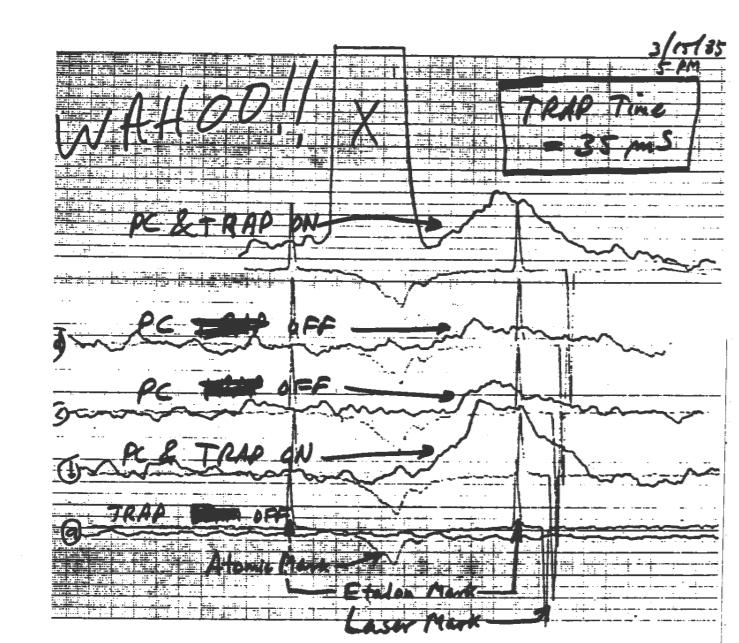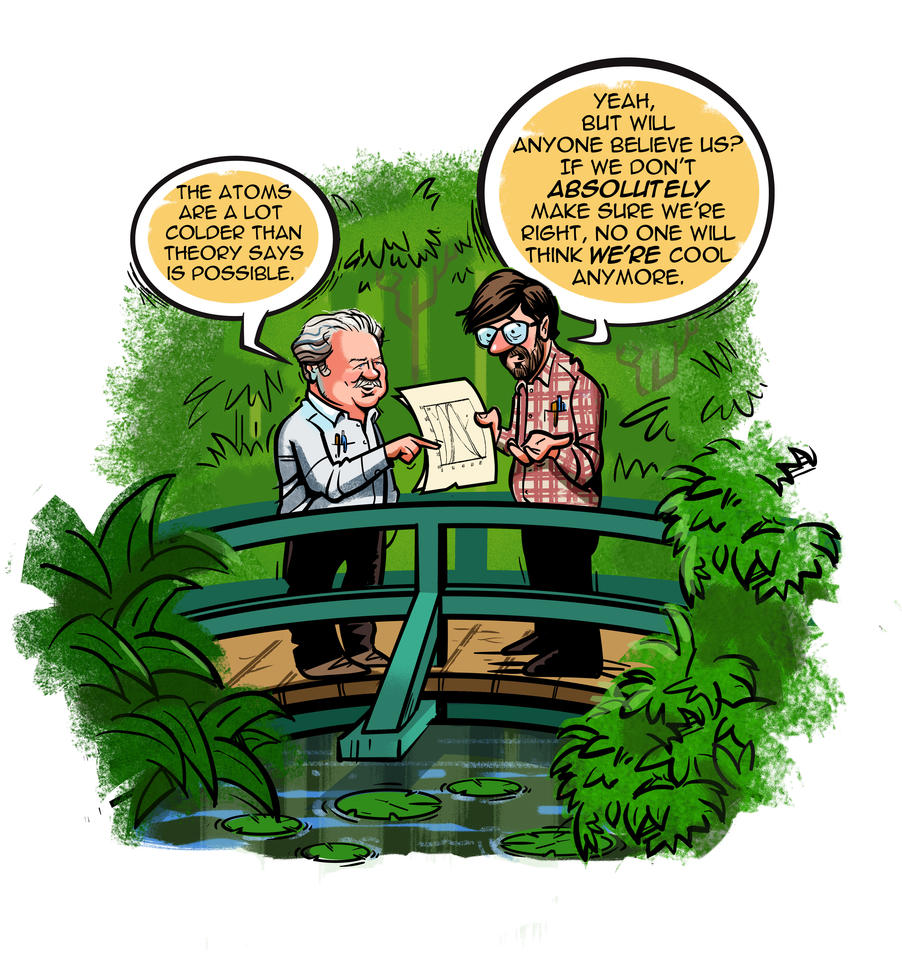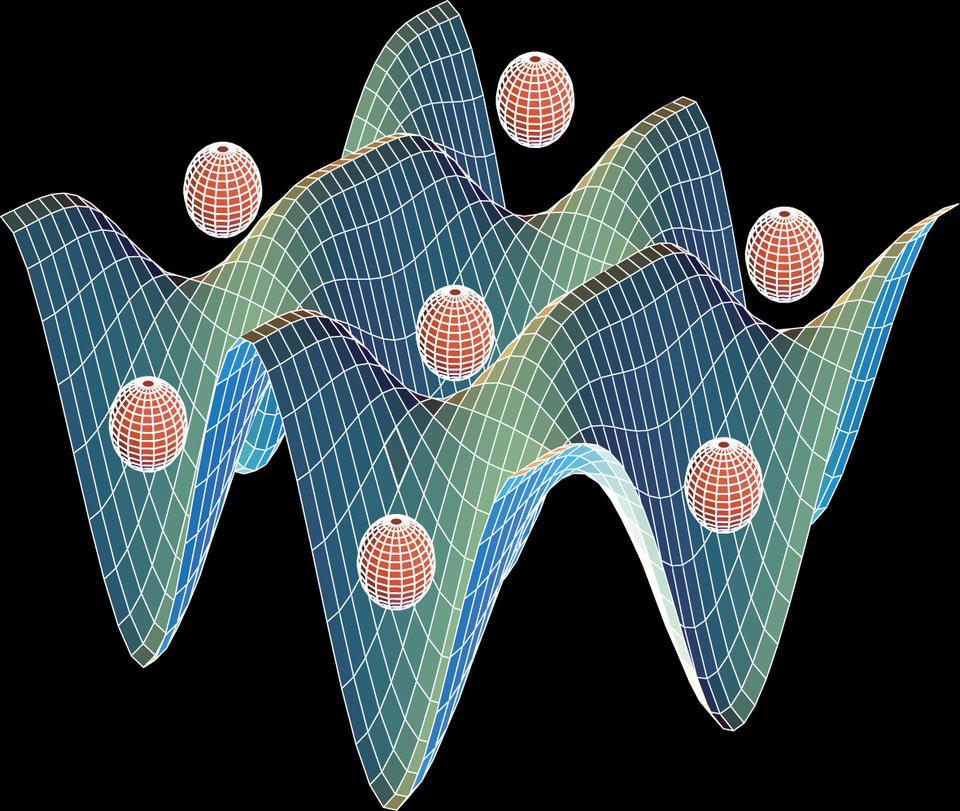The Nobel Moment: Bill Phillips
Having succeeded in cooling sodium atoms using the Zeeman effect, Phillips and his team next sought to trap the atoms so they could then be used for other applications. So they set out to build a magnetic trap to capture the atoms they had already slowed down.
Phillips said of the magnetic trap, “It was not so much a direct line to where we wanted to go, but rather, we thought magnetic trapping was something people had been talking about for a long time,” he recalls. “If we had atoms confined in a trap, then they’re hanging around for a longer time. That’s got to be a good thing.”
Indeed, traps for capturing neutral particles had been proposed as early as the 1950s, and Wolfgang Paul of the University of Bonn in Germany had successfully trapped neutrons in a magnetic field in 1978. Phillips and his collaborator, Harold Metcalf, a visiting researcher from Stony Brook University in New York, considered Paul’s design, but found it too complicated for their purposes. Instead, Phillips proposed they use two coils of wire. The coils would be concentric with each other but separated in space and wound in opposite directions. This arrangement would create a region in space where, if an atom placed there were to move in any direction, it would experience a force pushing it back—similar to how gravity keeps a ball at the bottom of a valley.
Metcalf thought the idea was way too simple to work.
“And I said, ‘Oh, yes, this is going to work,’” Phillips remembers. “And I think we bet a nickel on it.”
In 1985, the first magnetic trap for atoms corralled a golf-ball-sized sodium cloud with an average energy equivalent to a temperature of 17 millikelvin. The cloud stayed put for an average of less than a second, until stray gas molecules in the experiment’s imperfect vacuum chamber crashed through and scattered the trapped atoms. But the researchers’ calculations showed that, in a perfect vacuum, the trap would hold atoms for many hours. Metcalf handed over the nickel.

Meanwhile, Steven Chu at Bell Laboratories in Murray Hill, New Jersey, set to work on laser-cooling gases of untrapped atoms. Phillips had needed just one laser to slow an atomic beam of sodium atoms. Chu’s experiment, which he and his colleagues reported in 1985, involved three mutually perpendicular pairs of lasers opposing each other. In part using “chirp cooling” techniques, which rapidly adjust a laser’s frequency to stay in tune with atoms slowing down in a trap, Chu’s experiment herded a cloud of sodium atoms and held them in place for half a second, until they leaked away. (Chirp cooling also was employed by JILA scientist John L. Hall, who shared the 2005 Nobel Prize in Physics. JILA is a joint institution of NIST and the University of Colorado Boulder.)
Chu’s team called the confluence of lasers “optical molasses” because the light field acted as a viscous force—a goo in which atoms were stuck. The scientists measured the atoms’ temperature to be 240 microkelvin (millionths of a degree above absolute zero).
With the magnetic trap behind them, Phillips’ NIST team decided in 1987 to reproduce Chu’s optical molasses experiment. Initially, they found the same temperature that Chu had reported. Subsequently, however, they found that other properties of the optical molasses did not agree with theoretical predictions. In an attempt to understand the discrepancy, Phillips and his colleagues decided to re-measure the temperature, this time using more sophisticated methods. To their surprise, they found that the atoms had a temperature as low as 40 microkelvin—a sixth of the temperature Chu had reported. This was particularly significant because the 240 microkelvin Chu had measured corresponded to the “Doppler limit,” which was, according to a widely accepted theory dating back a decade, the lowest possible temperature that atoms laser-cooled using the Doppler effect could reach.
“Six times lower means you don’t understand what’s going on,” Phillips says. “You don’t expect something like that to happen. … Our first reaction was, we must be doing something wrong.”
At the same time, Phillips says, “we understood that if what we were seeing was true, that this was big. Really an important thing.”

To ensure their result was correct, Phillips’ team ultimately came up with four different ways to measure the temperature of the atoms falling out of the optical molasses cloud. It was a painstaking process that took months, and one for which the NIST focus on precision measurement was uniquely suited. The team’s full results confirmed their initial findings and convinced physicists that they needed a new theory for laser cooling.
Chu’s group, as well as that of Claude Cohen-Tannoudji at the École Normale Supérieure in Paris, published new theories in papers starting in 1989, which helped Phillips and his colleagues cool cesium atoms to an even lower temperature. The Paris group reported temperatures of just 2.5 microkelvin in 1990. Phillips and his colleagues reached temperatures of 0.7 microkelvin by 1995.
An additional advance was the optical lattice, which Phillips’ team discovered by accident in the late 1980s. Rather than inferring the temperature of an optical molasses based on the speeds of atoms after the laser beams are suddenly shut off—as they had done earlier—Phillips’ team tried measuring the trapped atoms’ temperature directly. They used a laser to detect the Doppler shift of light bouncing off the atoms, yielding information that would reveal the speeds, and hence temperature, of those atoms. The team was surprised to find that the light from the atoms showed them to be confined in an array of microscopic traps resulting from the “standing wave” formed by the interfering laser beams. This was the beginning of optical lattices. The pattern of traps resembled an egg carton or a web of light, evoking the regular lattice structure of crystals.

These achievements formed the body of work recognized in the 1997 Nobel Prize.
“What I like in Bill’s work, is that his ideas are elegant, they are beautiful, very simple to explain and to understand. Which is not always the case. There are many people advancing ideas which are very complicated. With Bill not.”
– Claude Cohen-Tannoudji, physicist at École Normale Supérieure in Paris; shared 1997 Nobel Prize in Physics with Bill Phillips

